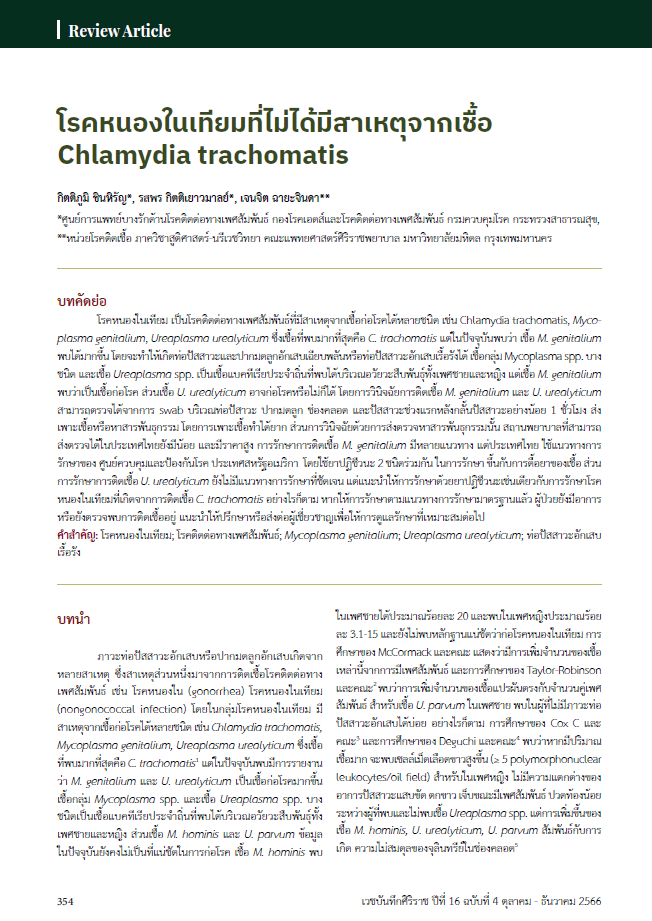Non-Chlamydial Non-Gonococcal Infection
Main Article Content
Abstract
Non-gonococcal infection is a sexually transmitted infection (STI) which has many etiologic organisms such as Chlamydia trachomatis, Mycoplasma genitalium, Ureaplasma urealyticum etc. Of them, the most common one is C. trachomatis. However, M. genitalium has been increasingly reported and recent evidence shows that it can cause acute or persistent urethritis and cervicitis. Some species of Mycoplasma spp. and Ureaplasma spp. are normal commensal flora in the both male and female genital tracts. U. urealyticum has also been reported as a pathogen but more evidence is further required. M. genitalium and U. urealyticum infections are diagnosed by the swabs of the urethra, cervix, vagina, and first void urine for culture or nucleic acid amplification test (NAAT). The culture of these organisms is complicated and impractical in real-life practice. For the NAATs, only few hospitals can accommodate due to its high cost. Thailand follows the treatment guideline provided by the Centers for Disease Control and Prevention, United States which uses a combination of two antibiotics based on the antibiotic susceptibility. For the treatment of U. urealyticum infection, there is no consensus on the recommended treatment regimen. As a result, in case of non-gonococcal infection of which the specific organisms cannot be identified, antibiotics for the treatment of C. trachomatis should be initiated and follow-up should be scheduled. If the patient has persistent symptoms or other organisms are later detected, consultation or referral to a specialist is recommended for further proper management.
Article Details

This work is licensed under a Creative Commons Attribution-NonCommercial-NoDerivatives 4.0 International License.
References
Centers for Disease Control and Prevention. Sexually Transmitted Infections Treatment Guidelines, 2021. MMWR Recomm Rep 2021;70(4):60-82.
Taylor-Robinson D, McCormack WM. The genital mycoplasmas (second of two parts). N Engl J Med 1980;302:1063-7.
Cox C, McKenna JP, Watt AP, Coyle PV. Ureaplasma parvum and Mycoplasma genitalium are found to be significantly associated with microscopy-confirmed urethritis in a routine genitourinary medicine setting. Int J STD AIDS 2016;27:861-7.
Deguchi T, Shimada Y, Horie K, et al. Bacterial loads of Ureaplasma parvum contribute to the development of inflammatory responses in the male urethra. Int J STD AIDS 2015;26:1035-9.
Horner PJ, Donders G, Cusini M, Gomberg M, Jensen JS, Unemo M. Should we be testing for urogenital Mycoplasma hominis, Ureaplasma parvum and Ureaplasma urealyticum in men and women?-a position statement from the European STI Guidelines Editorial Board. J. Eur. Acad. Dermatol. Venereol. 2018;32:1845-51.
Waites KB, Xiao L, Paralanov V, Viscardi RM, Glass JI. Molecular methods for the detection of Mycoplasma and Ureaplasma infections in humans. J Mol Diagn. 2012;14(5):437-50.
ราชวิทยาลัยสูตินรีแพทย์แห่งประเทศไทย. แนวทางเวชปฏิบัติสำหรับการรักษาภาวะระดูขาวผิดปกติในสตรีวัยเจริญพันธุ์. เวชบันทึกศิริราช. 2566;16(1):18-29.
Yu J, Zhou Y, Luo H, Su X, Gan T, Wang J, et al. Mycoplasma genitalium infection in the female reproductive system: Diseases and treatment. Front. Microbiol. 2023;14:1098276.
Zhang Z, Zong X, Bai H, Fan L, Li T, Liu Z. Prevalence of Mycoplasma genitalium and Chlamydia trachomatis in Chinese female with lower reproductive tract infection: a multicenter epidemiological survey. BMC Infect Dis 2023;23(2):1-11.
World Health Organization. Guidelines for the management of symptomatic sexually transmitted infections. Geneva: World Health Organization;2021:43-4.
Lesiak-Markowicz, I., Tscherwizek, C., Pöppl, W, et al. Prevalence of selected sexually transmitted infectious agents in a cohort of asymptomatic soldiers in Austria. Parasites Vectors 2022;15(424):1-8.
Dev T, Taneja N, Juyal D, Dhawan B, Gupta S. Upper genital tract infection due to Ureaplasma urealyticum: Etiological or syndromic management?. Indian J Dermatol Venereol Leprol 2017;83:489-91.
Tabla VO, Gutiérrez F. Cervicitis: Etiology, diagnosis and treatment. Infecc Microbiol Clin. 2019;37(10):661-7.
Doroftei B.; Ilie OD, Armeanu T, Anton E, Scripcariu I, Maftei R. The Prevalence of Ureaplasma Urealyticum and Mycoplasma Hominis Infections in Infertile Patients in the Northeast Region of Romania. Medicina 2021;57(211):1-9.
Ezeanya-Bakpa ChCh, Agbakoba NR, Oguejiofor ChB, Enweani-Nwokelo IB. Sequence analysis reveals asymptomatic infection with Mycoplasma hominis and Ureaplasma urealyticum possibly leads to infertility in females: A cross-sectional study. Int J Reprod BioMed 2021;19:951-58.
Tadera K, Kitagawa H, Kitano H, Hara T, Kashiyama S, Nomura T, et al. Prevalence of Mycoplasma hominis, Ureaplasma urealyticum, and Ureaplasma parvum detection in urine and respiratory tract samples in Hiroshima, Japan, HELIYON 2023;E14543.
Cai S, Pan J, Duan D, Yu C, Yang Z, Zou J. Prevalence of Ureaplasma urealyticum, Chlamydia trachomatis, and Neisseria gonorrhoeae in gynecological outpatients, Taizhou, China. J Clin Lab Anal. 2020;34:e23072.
Kokkayil P, Dhawan B. Ureaplasma: Current perspectives. Indian J Med Microbiol 2015;33:205-14.
Wada K, Hamasuna R, Sadahira T, Araki M, Yamamoto S. UAA-AAUS guideline for Mycoplasma genitalium and non-chlamydial non-gonococcal urethritis. J. Infect. Chemother 2021;27(10):1384-8.
Song J, Wu X, Kong Y, Jin H, Yang T, Xie X, et al. Prevalence and antibiotics resistance of Ureaplasma species and Mycoplasma hominis in Hangzhou, China, from 2013 to 2019. Front. Microbiol. 2022;13:982429.
Cutoiu A, Boda D. Antibiotic Resistance of Ureaplasma urealyticum and Mycoplasma hominis in the Romanian Population. FARMACIA 2023;71(1):65-71.






